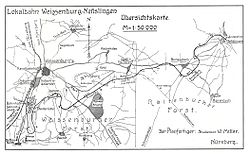Weißenburg – Nennslingen local railway
| Weißenburg – Nennslingen (project 1903) |
|||||||||||||||||||||||||||||||||||||
|---|---|---|---|---|---|---|---|---|---|---|---|---|---|---|---|---|---|---|---|---|---|---|---|---|---|---|---|---|---|---|---|---|---|---|---|---|---|
|
Planned railway line
| |||||||||||||||||||||||||||||||||||||
| Route length: | 23 km | ||||||||||||||||||||||||||||||||||||
| Gauge : | 1435 mm ( standard gauge ) | ||||||||||||||||||||||||||||||||||||
|
|||||||||||||||||||||||||||||||||||||
The Weißenburg – Nennslingen local railway is an unrealized railway project in the Weißenburg district in Bavaria .
history
From the late 19th to the early 20th century there were efforts to build a local railway from Weißenburg to the plateau of the Weißenburger Alb to Nennslingen .
Weißenburg was connected to the railway network on October 2, 1869 in connection with the construction of the Altmühlbahn with the Treuchtlingen – Pleinfeld section by the Royal Bavarian State Railways . Soon there were calls to build a railway line to Nennslingen.
The city of Weißenburg joined in 1899 with the Berlin railway construction company R. Burchart & Cie. in contact to clarify how such a route could be financed and built. Initial plans envisaged a route from Weißenburg train station through the Schambachtal via Schambach , Suffersheim and Laubenthal to Raitenbuch and on to Nennslingen.
A similar route was sought in competition by the city of Treuchtlingen . Since Schambach withdrew from the project at an early stage, the Franconian Alb was to be conquered directly at Oberhochstatt . More precise planning followed in 1902 and 1903, with calculations being carried out for the first time on the expected quantities of goods.
Interim status of the Ministry of Transport
The Royal Bavarian State Ministry for Transport Affairs announced the following to the city of Weissenburg on June 20, 1907: For some years now, three routes have been in competition with one another to develop the Jura plateau near Nennslingen.
These were the routes:
- Weißenburg – Oberhochstatt – Burgsalach-Raitenbuch – Nennslingen
- Weißenburg - Weiboldshausen - Geyern - Nennslingen
- Treuchtlingen – Schambach – Suffersheim – Burgsalach – Nennslingen
With the normal distance surcharges, the operating expenses for the first two proposals would only cover half, and for the third proposal only two thirds. The third line would have the heavier freight traffic because of the considerable timber removal and the lowest operating expenses because of the fewer local difficulties . With regard to passenger traffic , the first line should be preferred because of the traffic from the associated communities to the district office and district court of Weißenburg .
Railway Committee
Mayor Leyerer from Nennslingen became the first chairman of a railway committee in 1910, which was supposed to promote the railway construction. On May 25, 1910, he addressed the Reichsräte and the Bavarian State Ministry of Transport for the first time. He underscored his demand with the expected amount of goods and asked on behalf of 46 municipalities for an early construction. His proposal was to build a line from Weißenburg – Nennslingen – Weigersdorf or Weißenburg – Suffersheim – Nennslingen.
In terms of freight transport, 3,400 loaded railway wagons were expected annually from a cement works still to be built between Weißenburg and Dettenheim as well as freight from agriculture and forestry and the local quarries.
Further planning
The outbreak of the First World War prevented implementation. After the war the demand was taken up again. In October 1919 a petition was submitted to the state parliament , followed in December 1919 by a letter from Weissenburg's mayor August Lober to the Reich Treasury in Berlin.
In the following year, the planned route was included in the overview of the expansion of the Bavarian rail network, the type of federal transport route plan at that time , in Group II, branch lines . A continuation of the line via Nennslingen via Titting to Altdorf was mentioned here, although it would only have been a short distance from Altdorf to Beilngries , the terminus of the Altmühlbahn Eichstätt – Beilngries .
In a decision of March 15, 1923, the Reich Railway Directorate Nuremberg announced that the investigations by the Reich Ministry of Transport had led to an unfavorable result. The construction of the railway was therefore rejected by the highest authorities.
The city of Weißenburg made one last attempt in January 1926 at the Reichsbahndirektion in Munich . From there she received the answer that she had to finance the construction of the railway herself.
The Weißenburg – Nennslingen local railway project was therefore never implemented. Only the route to the planned Weißenburg-Industriebahnhof station was built later as an urban industrial track, but was shut down again at the end of the 1990s.
Individual evidence
- ^ Gustav Mödl: Weissenburg Railway History . In: villa nostra. Contributions to the history of Weißenburg . No. XX , March 1985, p. 177-192 .
Web links
- Emergency work, here: - Reich and state subsidies for emergency work in the Upper Palatinate. Duration: 1919 - 1921. In: German Digital Library. Bavarian Main State Archives, accessed on January 16, 2017 .
- Bavarian State Parliament: Negotiations 1919–1933. 35th meeting January 30th, 1920, Speaker: Wohlmuth Dr. George. In: Session period: Session period 1919–1920, Vol. 2: Stenographic reports on the public sessions 1919/1920 Nos. 28–58. geschichte.digitale-sammlungen.de - Munich Digitization Center, accessed on January 16, 2017 .
